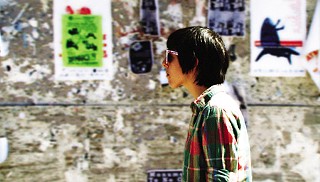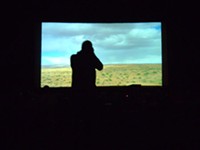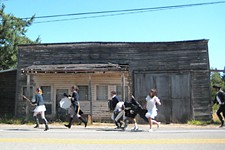Living Music in the Live Music Capital
'Echotone' explores the intersection of art and commerce in Austin
By Josh Rosenblatt, Fri., April 22, 2011
About 30 minutes into the documentary Echotone, a speaker at a 2008 Austin City Council meeting says that an "echotone" is the place where nature and civilization meet. Where he got that definition is beyond us, but the word is the perfect title for director Nathan Christ's film, which tells the story of the Austin indie music scene as it struggles to understand its place in a rapidly growing, rapidly gentrifying, upwardly mobile Downtown landscape. Christ, a former University of Texas film student and self-described "fanboy" of the Red River indie rock scene, talks to developers, club owners, and musicians – including Ghostland Observatory, White Denim, Belaire, and Black Joe Lewis & the Honeybears – to try to understand how a small city famous for its live music can maintain its identity in a new world of million-dollar condos, sound ordinances, and proposed Downtown redevelopment projects like the Waller Creek District Master Plan.
In advance of Echotone's theatrical opening this Sunday, April 24, at the Alamo Drafthouse at the Ritz, the Chronicle spoke with Christ about what life is truly like at Austin's echotone, that being the point where art and commerce meet.
Austin Chronicle: Why did you decide to make this film?
Nathan Christ: It all started with White Denim and Black Joe Lewis. One of the producers of the movie, Vic Moyers, had just seen White Denim play a show and he played me their record at four in the morning that night. He said, "This is happening in our city right now," and I was blown away. I had the same feeling with Black Joe Lewis: I couldn't believe there were people my own age doing this Downtown in my city.
We'd been shooting footage of Belaire since April, sort of a promo piece shot at rehearsals and shows, and we decided to shoot a documentary about this music scene we loved. So we put on a big concert called ATX Converge in September 2008 with those bands and filmed the entire thing with three cameras. Originally it was just going to be a movie about the music scene, but right after the show someone pointed at Black Joe Lewis and said, "By the way, he doesn't make anything off of his music, even though he's blowing up. He delivers fish for a living for Quality Seafood." That's when it clicked: I knew the music industry was collapsing, and I knew that could be an incredible dichotomy to explore. I knew I could explore art and commerce and find out what these musicians thought of it themselves.
AC: What ideas were you hoping to explore?
NC: I knew how much people were complaining about the condos and the sound ordinances. But I knew it went deeper than just the yuppies moving in; I realized how the plans were to change Austin's future. For better or for worse, depending on where you stand, it was all under way and it was all happening at once. I started looking at how that was affecting the venues these musicians were playing at. How do the sound ordinance and Downtown development affect these venues? And at the heart of it, how long could venues like those on Red River sustain with the street values skyrocketing?
But we're not just shaking our fist at progress. Finding a balance was a process of self-discovery for me, and I still see things from both sides. As we made the film, I could completely vacillate in my head between hating the growth of the city and seeing its value. Millions of dollars have been invested in Waller Creek, and it could end up like the San Antonio River Walk, which I don't think is a great example of what Austin is or what Austin can be. Austin has an edge.
AC: What's next?
NC: I moved to Chicago from Austin eight months ago partially to expand the story of the movie. The more we travel around the country with it, the more I realize this story is happening in a lot of cities, whether it be ordinances or restrictions on venues or musicians barely scraping by. I have plans to shoot a pilot in Chicago this summer. We're hoping to do the same in New York and Los Angeles over the course of this year and try to get a miniseries happening. I envision it as a six-part miniseries where we intercut all the cities and musicians and stories together and create a big nationwide symphony out of all of it.
Echotone screens at the Alamo Drafthouse at the Ritz this weekend. For showtimes, see Film Listings.













